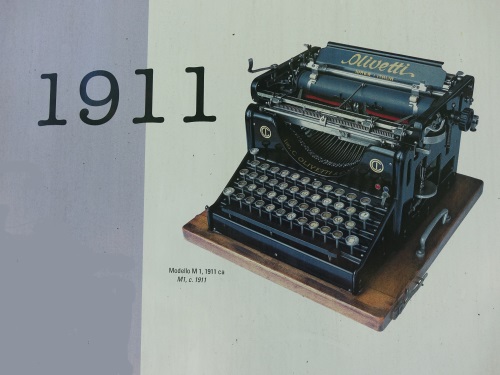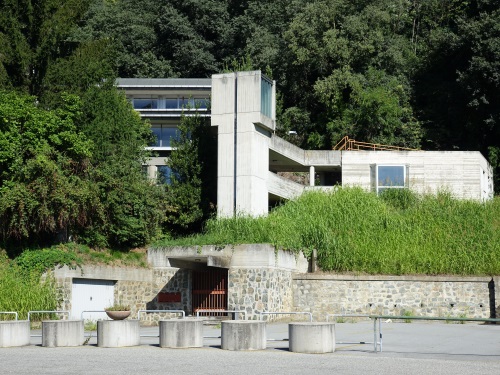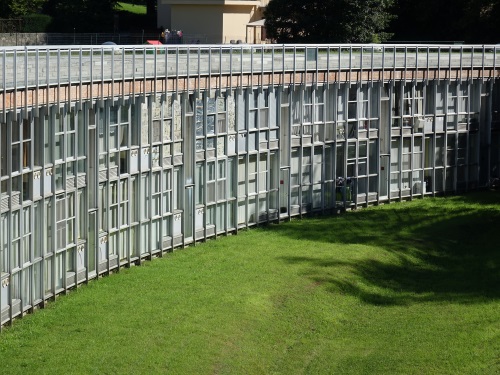Ivrea, industrial city of the 20th century will be submitted by Italy as their cultural nomination for 2018. It was actually already scheduled for 2017, but had to give way to the Venetian Defence Works. Ivrea lies in the foothills of the Alps, about an hour north of Turin. It’s a sizeable city of 25,000 inhabitants.
 |
| An original Olivetti typewriter made in Ivrea |
Travelling by train from Turin, you’ll surely know when you’ve arrived in Ivrea: the townscape near the train station is invariably modern with lots of apartment blocks. During the 20th century, the city was transformed into the Olivetti Company Town. Olivetti was a very successful producer of type writers and calculators (until the Age of Computers started). Especially Adriano Olivetti set the most famous Italian architects and planners to work during the period between 1930 and 1960. He promoted a different kind of company town, more geared to the community’s needs (gathered via questionnaires) and involving psychology.
This is going to be a serial nomination consisting of the Via Jervis and the Borgo Olivetti. The Via Jervis is the main drag of the modern city, the
Borgo Olivetti comprises six self-sufficient single-family homes nearby. The latter were commissioned by Camillo Olivetti (father of Adriano) in 1926. The local authorities have turned the former company town into an ‘Open Air Museum’: this means that several information panels are strategically placed around town. They also have launched a very informative
official website with a good map and detailed descriptions of the individual buildings.
 |
| Edificio ex Sertec, headquarters of the Engineering services |
The completionist in me would have liked a well-signed trail along all 42 of the proposed buildings, but the 'Open Air Museum' is a more associative route somewhat half-heartedly signposted around town. It includes industrial, residential and social facilities. Main focus on Via Jervis is a large factory building with many windows, similar to the Van Nelle Factory or Fagus Factory. Across the street lies a former library, and behind that a still in use kindergarten. Most of the nominated buildings are in private use, and some are hard to see from the street view due to high gates and trees.
The most remarkable of the buildings I found the
Unità Residenziale Ovest. Better known as ‘Talponia’ (which means Moleville), this is is an underground apartment complex. It is shaped as an amphitheatre, opening up only on one side to its natural environment. I was eager to get a closer look, but came across signs that access to the compound is forbidden. I did see an information panel though on top of the molehill, so I ignored the warnings and walked around a for a bit on what is the roof of the apartment complex. I doubted whether it is still lived in, some of the windows have been covered by newspapers. But earlier I saw two cars leave the (also underground) parking garage. The building was made for basic lodging for graduates and new workers. You can
buy one of these apartments today for 51,000 EUR. The photos of the interior made by the real estate company show a box-like structure basking in the sun.
 |
| Talponia / Moleville |
I spent some 2 hours in Ivrea and enjoyed my stay. It certainly is recommendable to the many modern architecture adepts active on this website (especially those with fond feelings for Le Corbusier). WH status almost seems a last straw for Ivrea, as it looks a dying town in other aspects. “Today, “for sale” signs are ubiquitous in Ivrea. Some of the most iconic buildings commissioned by Olivetti lie empty and abandoned.” is the verdict of
this article; "the city has not been able to recover from the decline of Olivetti".
Thanks for highlighting this one Els, I hadn't really paid much attention to it previously. But it is one to bear in mind for future visits to the area, even if it doesn't make it onto the list.
Though I may pass on buying a holiday flat there :)